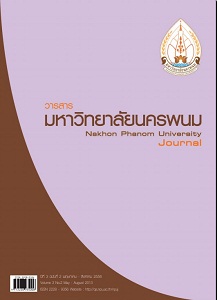การพัฒนาหลักสูตรรายวิชา เครื่องปั้นดินเผาบ้านเชียงเครือ กลุ่มสาระการเรียนรู้ การงานอาชีพและเทคโนโลยี ชั้นมัธยมศึกษาปีที่ 2 โรงเรียนท่าแร่ศึกษา สำนักงานเขตพื้นที่การศึกษามัธยมศึกษา เขต 23
Main Article Content
Abstract
การวิจัยครั้งนี้มีวัตถุประสงค์เพื่อ 1) พัฒนาและหาประสิทธิภาพหลักสูตรรายวิชา เครื่องปั้นดินเผาบ้านเชียงเครือ กลุ่มสาระ การเรียนรู้การงานอาชีพและเทคโนโลยีชั้นมัธยมศึกษาปีที่ 2 โรงเรียนท่าแร่ศึกษา สำนักงานเขตพื้นที่การศึกษามัธยมศึกษา เขต 23 ที่มี ประสิทธิภาพตามเกณฑ์ เท่ากับ 80/80 2) เปรียบเทียบผลสัมฤทธิ์ทางการเรียนของนักเรียน ระหว่างก่อนและหลังเรียนด้วยหลักสูตร ที่สร้างขึ้น 3) ศึกษาทักษะการปฏิบัติงานของนักเรียน และ 4) ศึกษาเจตคติต่อการเรียนของนักเรียนด้วยหลักสูตรที่สร้างขึ้น กลุ่มตัวอย่างที่ใช้ในการวิจัย คือนักเรียนชั้นมัธยมศึกษาปีที่ 2 โรงเรียนท่าแร่ศึกษา ภาคเรียนที่ 1 ปีการศึกษา 2555 จำนวน 34 คน ได้มาโดยการสุ่มแบบกลุ่ม เครื่องมือที่ใช้ในการเก็บรวบรวมข้อมูล ได้แก่ 1) แบบสอบถามความต้องการและความคิดเห็นในการจัดทำ หลักสูตร แบบมาตราส่วนประมาณค่า 5 ระดับ มีความเหมาะสม อยู่ในระดับมาก 2) แบบทดสอบผลสัมฤทธิ์ทางการเรียน ชนิดเลือก ตอบ 4 ตัวเลือก จำนวน 40 ข้อ มีค่าความยากตั้งแต่ 0.35-0.80 ค่าอำนาจจำแนก อยู่ระหว่าง 0.20-0.80 ค่าความเชื่อมั่นเท่ากับ 0.81 3) แบบทดสอบภาคปฏิบัติทักษะการปฏิบัติงาน มีค่าความสอดคล้องระหว่างทักษะที่ต้องการวัดกับจุดมุ่งหมายที่กำหนดไว้เท่ากับ 1.00 หมายถึงมีความเหมาะสมในระดับมาก สามารถนำไปใช้ได้ และ 4) แบบวัดเจตคติของนักเรียนที่มีต่อการเรียนด้วยหลักสูตร ประกอบด้วย ข้อความ จำนวน 25 ข้อ สถิติที่ใช้ในการวิเคราะห์ข้อมูล ได้แก่ ร้อยละ ค่าเฉลี่ย ส่วนเบี่ยงเบนมาตรฐาน ทดสอบสมมติฐานโดย การทดสอบค่าที t-test (Dependent Samples) ผลการวิจัยพบว่า 1) หลักสูตรรายวิชา เครื่องปั้นดินเผาบ้านเชียงเครือที่พัฒนาขึ้น มีความหมาะสมอยู่ในระดับมาก ( = 4.43) และมีประสิทธิภาพ เท่ากับ 83.25/81.32 ซึ่งเป็นไปตามเกณฑ์ที่กำหนด 2) ผลสัมฤทธิ์ ทางการเรียนของนักเรียนสูงกว่าก่อนเรียน อย่างมีนัยสำคัญทางสถิติที่ระดับ .01 3) ทักษะการปฏิบัติงานของนักเรียน มีคะแนนเฉลี่ย เท่ากับร้อยละ 80.03 ซึ่งสูงกว่าเกณฑ์ที่กำหนดไว้ที่ร้อยละ 70 และ 4) เจตคติของนักเรียนที่มีต่อการเรียนตามหลักสูตร โดยภาพรวม อยู่ในระดับมากที่สุด (
= 4.82)


